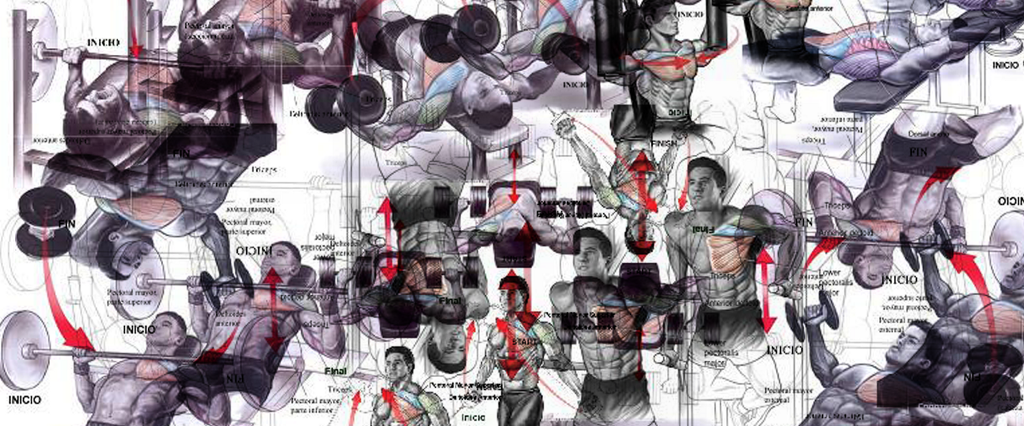For the past four months, Shravan Upadhayay, a 30-year-old tech consultant in Faridabad, India, has been on a strict workout regime. He lifts four to five times a week and does one high-intensity cardio session at a small, cheap gym at an old motorcycle repair shop near his house. Similarly, he’s adopted a strict diet, complete with a meal prep schedule that includes measurements of how much his food should weigh. His goal is to both add more muscle and become more toned.
He, like many other men, had been using YouTube videos from the platform’s most well-known fitness influencers (e.g., Mike Chang, Elliott Hulse and Jeff Nippard) to do so. Yet, he wasn’t getting the results he wanted. “I found YouTube very limiting,” he tells me over Skype. “They’d show some workout or some technique, but I didn’t know what it was doing — or how long I should do it for. It was very confusing.”
Moreover, he found the videos unhelpful when it came to adjusting his diet. Because most fitness YouTubers tend to be from North America, there were certain foodstuffs — namely, beef and egg whites — that were difficult to come across, especially when living in a devout Hindu community that abides by strict vegetarianism. But what frustrated Upadhayay most was that the guys promoting fitness on YouTube were “always selling protein powders and supplements,” suggesting that they were the key to getting the body he wanted. “The videos just felt like they were [advertisements],” Upadhayay says. “When I finished watching them, I didn’t learn anything.”
Earlier this year, though, Upadhayay came across an online community that shared a very similar fitness journey to his: A Facebook group called Gym Workout Chart. The group, which has nearly 2 million members, is dedicated to workout charts — showing detailed images of the precise muscle groups that particular weights and exercises target. These charts tend to be considered old school by modern standards — think of the posters showing muscle groups at your gym that are typically gathering dust and peeling off the walls.
Yet, despite their antiquated feel, workout chart Facebook groups are growing. Gym Exercise Chart has 160,000 subscribers, and Gym Workouts has 26,000. Another, Bodybuilding Tips and Tricks, has a community (24,000 subscribers strong) that not only shares muscle-chart photos, but also motivational fitness memes, usually targeted at gym newbies.
“The popularity of these charts is like a return to 1950s beach-side bodybuilding,” says Oliver Lee Bateman, a former competitive powerlifter and a contributing writer to MEL. To Bateman, the charts are a stripped-down, no-nonsense approach to fitness and muscle building, something that he was exposed to at a young age through former American bodybuilder Bill Pearl’s book Getting Stronger, a volume that’s still considered a classic in modern powerlifting communities. Generally speaking, methods that used muscle workout charts, Bateman says, were targeted for beginners, especially those who, back in the golden age of bodybuilding, couldn’t afford to go to well-stocked gyms or get personal training. “As someone who only owned a barbell and several different dumbbells, it was an efficient way to manage my training,” Bateman says. “I didn’t learn about the finer details of training until I started going to powerlifting-centered gyms later in life.”
Essential Reads for the Man Who Wants to Put on A Little Muscle
For Upadhayay, who says he subscribes to around 10 of these Facebook groups, the fitness charts offer one thing that other fitness guides and YouTube videos don’t: Simplicity. “I can use the charts to know what excercises I will do each day,” he explains. “I can save the images on my phone and know that, if I want to work out my chest, I will do bench press, squat and shoulder press. I know exactly what muscles will work.” Using the charts, Upadhayay also was able to refine his research regarding technique. “For example, I know that I’ll need to squat three times a week,” he says. “So I can just research squats — wide squats or box squats — and know what’s more useful to me [based on] what muscle I want to work on.”
“We have men who have been working out their whole lives, men who have never been to a gym and men who are amateur bodybuilders who want to give advice to people just starting out,” says Shaker Tanwar, an admin of the group Workout Chart II, one of Facebook’s biggest workout chart groups. Shaker describes himself as an amateur bodybuilder, but his main goal, he explains, is to promote fitness to men who don’t know where to begin, or who don’t come from places where gym facilities are readily available.
“We have many men from India, Pakistan and parts of East Africa,” Tanwar tells me over WhatsApp. “They all have [similar] stories. They want to be healthier, but they live in places where there isn’t a gym, or there isn’t space to exercise outside. So they want to know what they can do with simple materials. Some even build [weights] on their own, using stones or bricks, because they can��t afford to buy [equipment].”
“There are men who post pictures of their progress so they can receive comments, or they will ask questions about what they can do to lose weight or build muscles,” Tanwar continues. “Other times, members will make exercise plans or diet plans that anyone can use.”
Tanwar cites one member from Nepal, who, after joining the group earlier this year, began posting his progress pictures to the group using a grainy, low-resolution phone camera. The post racked up nearly 100 likes. “It might be a small number in some communities,” Tanwar tells me. “But in ours, that’s huge because it’s the first time these men are showing [themselves] off in public.”
Upadhayay agrees. “[The groups] have made me more confident. I’m physically stronger, and I can also go into a gym anywhere and not feel nervous anymore.” Not to mention, he’s found his workout crowd — if only virtually. “It’s always good to see how people in the groups progress,” he says, when I ask about his interactions with other members. “I don’t post much, but I do see other people posting their progress photographs, their food and their plans.”
“It doesn’t matter where you come from or what language you speak,” he laughs. “Everyone can [benefit] because we all have the same body, and we can all learn from each other.”

